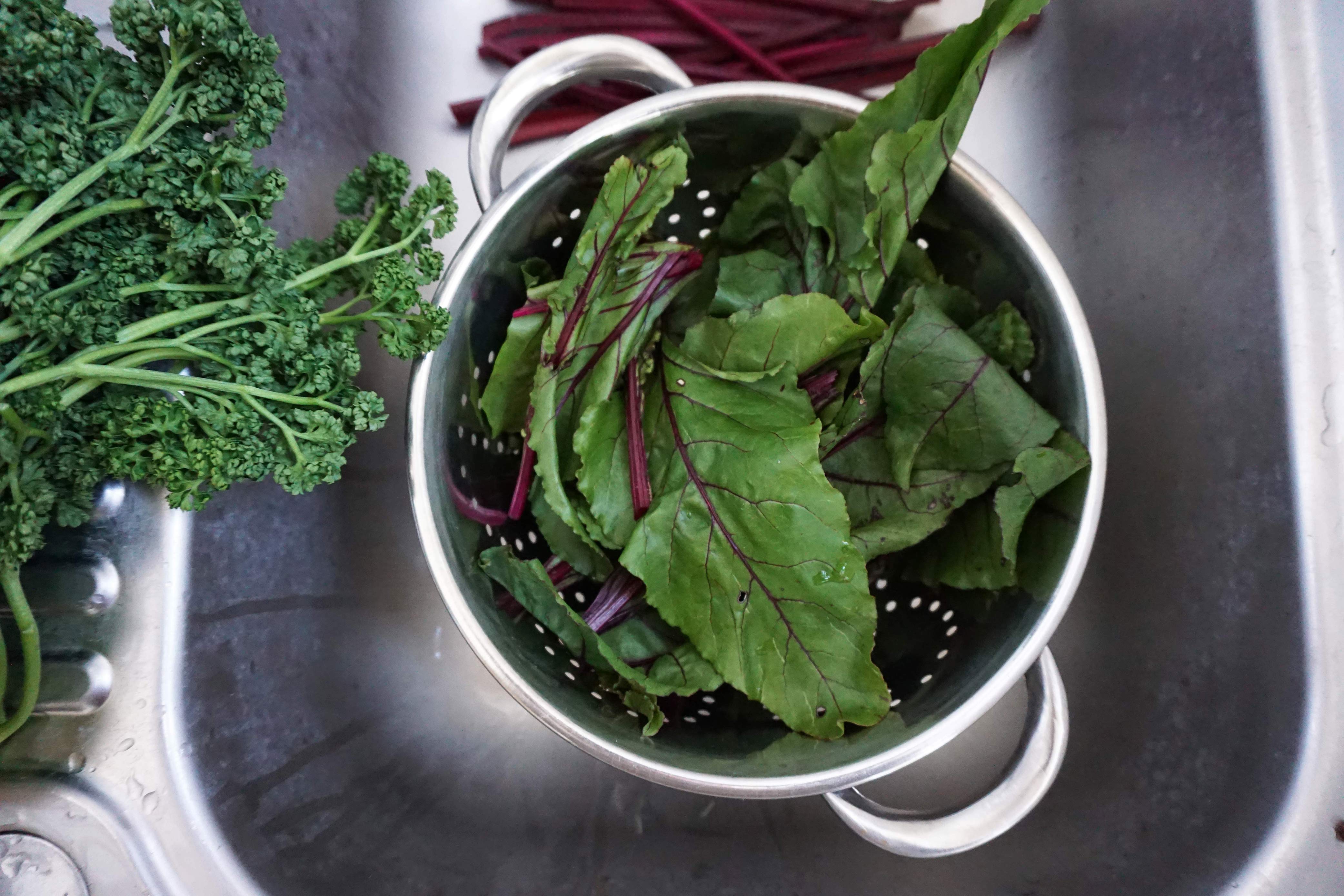Buying a bunch of beets with the leaves still attached will give you more meals for your buck. Tamar Adler (an absolute hero when it comes to cooking well and wasting little), says this: “beets love to be roasted, are better cold than hot, and wait, without losing their pluck, to be turned into different dishes all week long. Look for beets with their dark green leaves attached, then salvage them from their delicious roots and sauté them with garlic and olive oil.”
All true. Tasted raw, beet leaves are quite mild with an ever-so-slight peppery, sweet flavour. They’re nice enough, but wilt them in a hot pan and they are literally perfection. Anchovies are a good and I reckon, pretty compulsory addition – as a classic pair with beetroot, I suppose it makes sense that anchovy’s salty umami works so well with the leaves too.

Most shops cut off the tops from beetroot, much like they do with carrots and radishes. It’s worth, I’ve found, finding a market or greengrocer that sells their vegetables with the greens attached. They might be slightly more expensive, but actually they help stretch meals further and tend to be fresher than the bagged leaves you’d find in a supermarket. Once home, plan your meals to use the leaves first. I find they can lose their perkiness quite quickly, but chopping the stems off their root, then standing them in a centimetre or two of water will help keep them fresher for longer. Or sauté a batch and keep for use over the following days.
Once wilted, beet leaves make a good meal, either folded into an omelette or spooned onto hot, garlicky toasts; simple, back-of-fridge dinners that need just a couple of eggs or a bit of old bread to complete them. That aside, wilted beet leaves tossed through pasta is better than anything. Unlike rocket or spinach, both able to wilt down into a pasta sauce, beet leaves soften and wilt without losing themselves. Substantial and filling, they’re perfect for wrapping up on your fork with long pasta shapes (linguine, spaghetti, etc) bringing with them all that anchovy, garlicky flavour. Definitely up there with my favourite pasta dishes.
I tend to chop off a large part of the tough, purple stems. They can get in the way a bit. Any ideas how to use them?

Beet leaf & anchovy pasta
Serves 2
leaves from 3-4 beets
1 fat clove of garlic
2-3 anchovies (sustainably sourced)
200g linguine, spaghetti or other long pasta
olive oil
a sprig or two of fresh parsley
Parmesan cheese
Trim the beet leaves away from their stems and wash thoroughly. Peel and finely chop the garlic, then chop the anchovies. If you’re a particular fan of anchovies, use three of them, as I do.
Add the pasta to a large pan of boiling salted water and cook until al dente. Meanwhile, heat about 2 tablespoons of oil in a large frying pan or wok over a medium heat (you can use the oil from the anchovy jar if you want), add the garlic and anchovy, then fry for 1 to 2 minutes, or until softened. Add the beet leaves, season and cover with a lid. Cook over a medium-low heat for about 8 minutes, or until wilted.
Reserving some of the cooking water, drain and add the pasta to the wilted leaves. Toss well over the heat, adding splashes of cooking water to loosen it up, if needed. Serve with finely chopped parsley leaves, a grating of Parmesan and a drizzle of good olive oil.
Till the next time…
Store leftover fresh parsley by standing it up in a glass with a little water. Like a plant, it’ll last far longer than if you leave it thirsty.
Next time you have the oven on, scrub and trim your beetroots, then chop into wedges. Toss with woody herbs, like rosemary, whole unpeeled garlic cloves and olive oil, season, then roast for 30 minutes at 200ºC/400ºF. Nice in salads or served with roasted lamb or beef.
